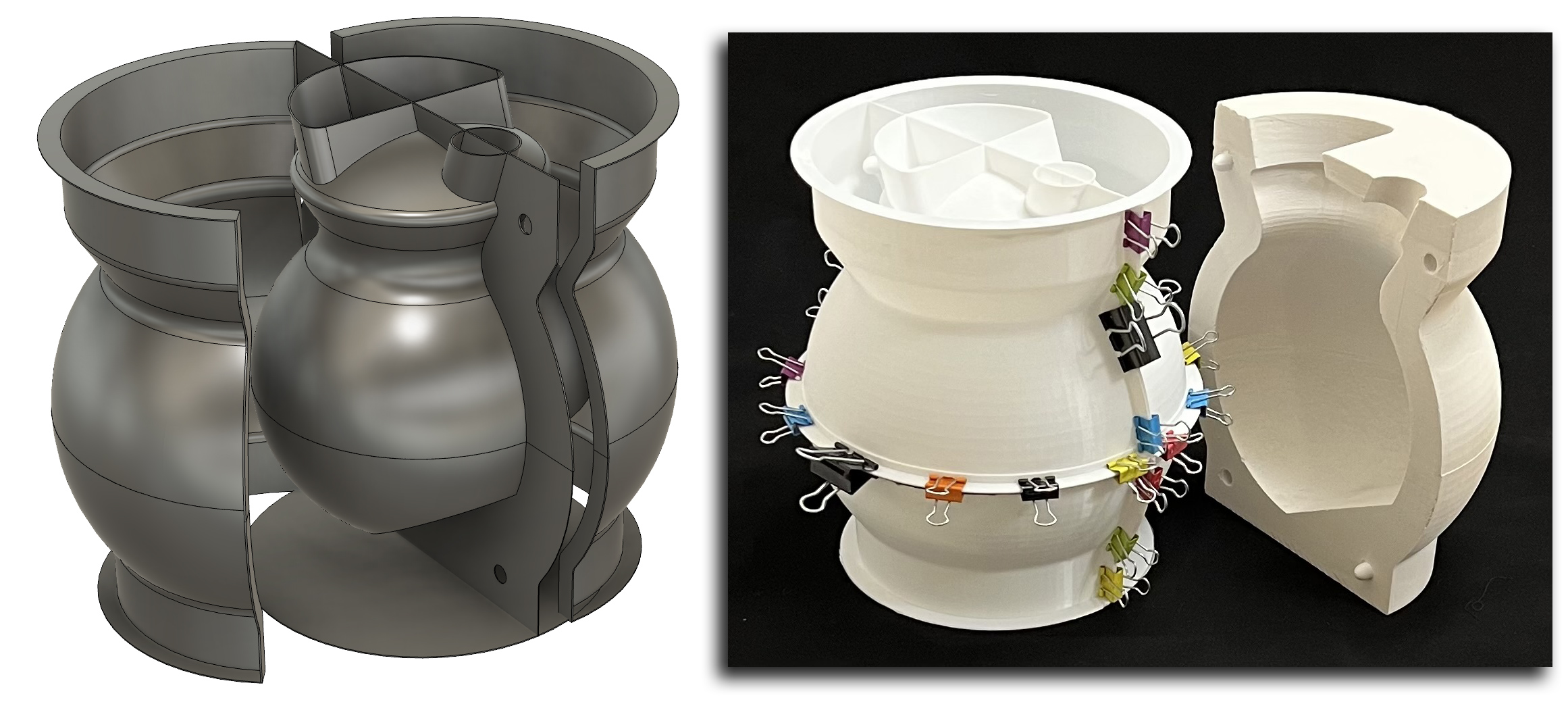| Monthly Tech-Tip | No tracking! No ads! | |
Fastest possible 3D print of a case mold part
I am 3D printing half of the bottom section of the outside shell assembly of an all-in-one case mold (to make a plaster mold for casting pottery). There are multiple factors to take into account to make this print quickly with minimum material and yet be strong.
- Notice the green 3mm wide brim all around the base (in the slicer view top right). The slicer generates that when asked, it helps stick the part to the printer bed.
- Flanges are present on all sides of these to enable clamping them together. The overall shape and flanges on a ready-to-pour assembly make for plenty of strength. However, the top, which is actually the down side when assembled, prints with no flange (so no printed support is needed). I print separate flanges (shown between the top and bottom pieces (on the left) and glue them on.
- I design with 0.8mm thick walls, these thus print in two passes (see video). This piece prints in about an hour on my machine. It weighs only 36g.
- If the flanges are not 0.8mm thick the printer makes separate motions there risking catching the edge and flexing the print on each pass (this eventually loosens it from the bed).
Related Pictures
Flanges enable an all-in-one 3D printed block mold for slip casting

This picture has its own page with more detail, click here to see it.
The center piece of this 3D printed assembly defines the outside shape of the ceramic vessel (plus two spares at the top). This entire assembly is an all-in-one case mold for a two-piece plaster working mold. This was printed as six light-weight units on standard Prusa MK3 and MK4 printers, walls are 0.8mm thickness. The upper and lower inside model halves were glued together (with the aid of an inside hoop to line them up). Outer flanges were glued on to enable clamping the outer shell vertically and horizontally.
The membranes defining mold mating points are printed onto the inside model, they extend out far enough to clamp between the flanges of the outer shell sections (suspending the model in the center). The membranes have holes to enable inserting natch-pairs. The thin base is glued on to hold the lower outer shells in place (in flexes enough to enable extracting the plaster form without mold breakage). The whole assembly is held together by clamps so it can be used multiple times.
The importance of profile in reduction of printed support

This picture has its own page with more detail, click here to see it.
In a 3D print, a small amount of infill can greatly outweigh the generation of a large amount of printed support. This can greatly reduce print time and filament consumption (this is printed with 0.8mm thick walls).
Far left: The green part is the support my slicer has generated in order to hold up the flat top flange. This is not only a waste but problems are likely with adhesion on the lower support sections where tiny points are printed on the steeply included surface to start each.
Middle: The same piece has been edited to terminate at the top with a triangular cross section. This is a 40 degree angle (as can be seen on the far right) - the slicer has been configured with an overhang threshold of 39 degrees, that means it does not need to generate support. It does infill that section, but the increase in time is minimal.
Videos
Links
| Glossary |
Infill and Support
Infill and support are structural elements that 3D slicer software uses (e.g. to fill the interior of solid parts or support contours over empty space) |
Got a Question?
Buy me a coffee and we can talk

https://digitalfire.com, All Rights Reserved
Privacy Policy
